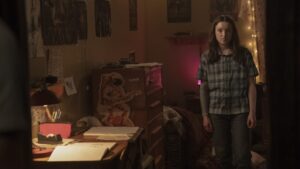Interiors by Design: Potted plants

Growing plants indoors is an ancient tradition, but it wasn’t until the nineteenth century that it became popular among the middle classes. While some were grown for their flowers, foliage plants became common, and in the later part of the century Aspidistra elatior became so widespread in Britain that it was a symbol of dull middle-class respectability and the bourgeoisie.
John Roddam Spencer Stanhope (1829–1908), Thoughts of the Past (1859), oil on canvas, 86.4 x 50.8 cm, The Tate Gallery (Presented by Mrs F. Evans 1918), London. © The Tate Gallery and Photographic Rights © Tate (2016), CC-BY-NC-ND 3.0 (Unported), http://www.tate.org.uk/art/artworks/stanhope-thoughts-of-the-past-n03338
The potted houseplants straggling up for light from the window in John Roddam Spencer Stanhope’s Thoughts of the Past (1859) are anything but respectable, though. Here they form part of the stereotype of one of London’s many prostitutes.
Carl Larsson (1853–1919), The Toy Corner (1887), further details not known. Wikimedia Commons.
In 1887, the young Swedish artist Carl Larsson painted The Toy Corner inside his family home. His wife Karin was a talented artist who concentrated on interior design, and was responsible for most of the interiors shown in her husband’s paintings. At the left is a collection of plants in red earthenware pots.
Paul Signac (1863-1935), La salle à manger (Breakfast, The Dining Room) (Op 152) (1886-87), oil on canvas, 89 x 116 cm, Kröller-Müller Museum, Otterlo, The Netherlands. Image by anagoria, via Wikimedia Commons.
At about the same time, Paul Signac pictured the bourgeoisie at table in La salle à manger, variously known as Breakfast or The Dining Room from 1886-87, perhaps his first major Neo-Impressionist painting. The man seen in profile with his cigar is Signac’s grandfather Jules, and the woman drinking coffee may be Signac’s mother. This is thoroughly middle class, with its uniformed maid, a spotless tablecloth, plush curtains and a potted plant in the window.
Paul Signac (1863-1935), Un Dimanche (Sunday) (Op 201) (1888 Oct – 90 Mar), oil on canvas, 150 x 150 cm, Private collection. WikiArt, Wikimedia Commons.
Sunday, which Signac started in October 1888 and completed in March 1890, is perhaps the best-known of his interiors, and continues their theme of the humdrum life of the bourgeoisie. Its static, stultified composition and atmosphere are intentional, and pervade its every detail down to the potted palms at the left.
Harriet Backer (1845–1932), Woman Sewing (1890), oil on canvas, 33 x 41 cm, Private collection. Wikimedia Commons.
Harriet Backer’s Woman Sewing (1890) shows a woman (a wife in the Norwegian title) sat at her sewing. This appears to have been a quick oil sketch, with its gestural depictions of potted plants, table, and chair.
Anna Ancher (1859-1935), Fisherman’s Wife Sewing (1890), oil on canvas, 59 x 48 cm, Randers Art Museum, Denmark. Wikimedia Commons.
The potted plants in Anna Ancher’s Fisherman’s Wife Sewing (1890) are in flower, and shown in their shadows cast on the wall by the sunlight pouring through a window to the left.
Christian Krohg (1852–1925), Eyewitnesses (1895), oil on canvas, 192 x 310 cm, Nasjonalgalleriet (purchased 1895), Oslo, Norway. Courtesy of Nasjonalmuseet, Oslo.
In 1895, Christian Krohg painted one of his more enigmatic works, a throwback to his social narratives, and something of a ‘problem painting’: Eyewitnesses. It is nighttime in a living room. Two fishermen stand in front of a door. Still wearing their soaked and soiled oilskins, they appear to have entered the room straight after coming ashore from the sea. One stares in shock towards the viewer, the other looks down and away. Both appear full of unease, silent and immobile.
At the right, a young woman is standing, leaning forward towards the men, as if listening to them. She looks anxious, with her hands clasped in front of her chest. Behind her an oil lamp burns brightly, there are the leaves of a large potted plant, and a couple of paintings on the wall behind a large blue settee.
Laurits Andersen Ring (1854–1933), At Breakfast (1898), oil on canvas, 52 x 40.5 cm, Nationalmuseum, Stockholm, Sweden. Wikimedia Commons.
In another world three years later, the Danish painter Laurits Andersen Ring’s wife Sigrid sits reading the ‘leftist’ daily newspaper Politiken At Breakfast in 1898. The furniture is modern, designed rather than thrown together, and colour-coordinated. By the window on the right is a small stack of potted plants enjoying the light.
Harriet Backer (1845–1932), Thorvald Boecks bibliotek (Thorvald Boeck’s Library) (1902), oil on canvas, 94.5 x 89 cm, Nasjonalgalleriet, Oslo. The Athenaeum.
Thorvald Boecks bibliotek (Thorvald Boeck’s Library) (1902) is one of Harriet Backer’s few interiors that is devoid of people, here replaced by books from floor to ceiling. Alongside the intricate detail of their many spines, furniture, and other decorations is a high potted plant at the left.
Nikolai Astrup (1880–1928), Interior Still Life: Living Room at Sandalstrand (c 1921), oil on board, 81.9 x 100.4 cm, Private collection. The Athenaeum.
The windowsills in Nikolai Astrup’s Interior Still Life: Living Room at Sandalstrand are full of plants enjoying the sheltered climate indoors.
Þórarinn B. Þorláksson (1867-1924), The Artist’s Home (1924), media not known, 35 x 25 cm, location not known. Wikimedia Commons.
Further north still, homes in Iceland’s capital Reykjavik had room for ample foliage, as shown in Þórarinn Þorláksson’s view of The Artist’s Home in 1924.
The aspidistra is still flying in domestic interiors today.

